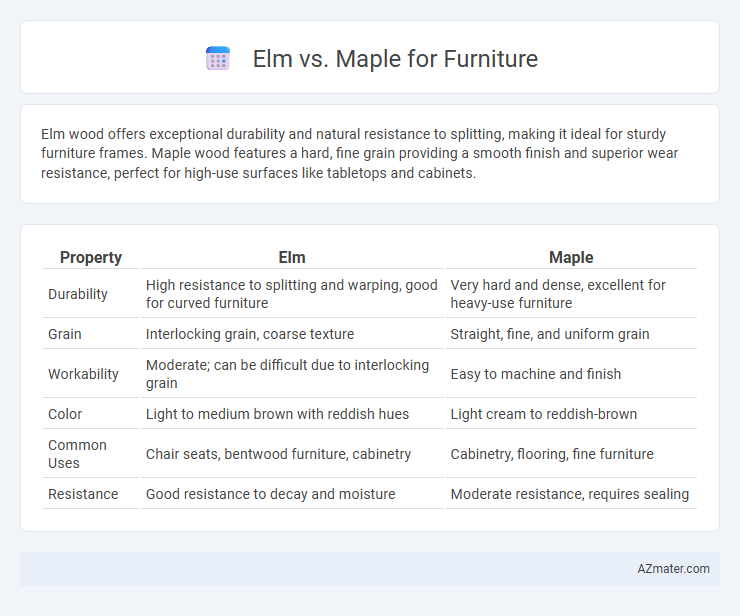Elm wood offers exceptional durability and natural resistance to splitting, making it ideal for sturdy furniture frames. Maple wood features a hard, fine grain providing a smooth finish and superior wear resistance, perfect for high-use surfaces like tabletops and cabinets.
Table of Comparison
| Property | Elm | Maple |
|---|---|---|
| Durability | High resistance to splitting and warping, good for curved furniture | Very hard and dense, excellent for heavy-use furniture |
| Grain | Interlocking grain, coarse texture | Straight, fine, and uniform grain |
| Workability | Moderate; can be difficult due to interlocking grain | Easy to machine and finish |
| Color | Light to medium brown with reddish hues | Light cream to reddish-brown |
| Common Uses | Chair seats, bentwood furniture, cabinetry | Cabinetry, flooring, fine furniture |
| Resistance | Good resistance to decay and moisture | Moderate resistance, requires sealing |
Introduction to Elm and Maple Wood
Elm wood is prized for its interlocking grain and durability, offering exceptional resistance to splitting and a distinctive wavy texture ideal for furniture making. Maple wood is renowned for its fine, consistent grain and hardness, providing a smooth, scratch-resistant surface favored in both traditional and contemporary furniture designs. The choice between elm and maple hinges on the desired aesthetic and functional qualities, with elm delivering rustic appeal and flexibility, while maple excels in strength and a polished finish.
Key Characteristics of Elm Wood
Elm wood is prized for its interlocking grain, which provides excellent resistance to splitting, making it highly durable and ideal for furniture that undergoes frequent use. Its medium to coarse texture and moderate hardness contribute to a sturdy yet workable material, offering a balance between strength and ease of crafting. The distinctive reddish-brown heartwood and golden sapwood of elm create attractive furniture pieces with natural warmth and rustic appeal.
Distinctive Features of Maple Wood
Maple wood is renowned for its durability and fine, uniform grain, making it an ideal choice for high-quality furniture that demands both strength and aesthetic appeal. Its natural light color ranges from creamy white to light reddish-brown, offering a sleek appearance that can be easily stained or finished to suit various design styles. Unlike elm, which features interlocking grain that resists splitting, maple's hard, dense texture makes it highly resistant to dents and scratches, ensuring longevity in furniture applications.
Appearance and Grain Comparison
Elm features a distinctive, interlocking grain pattern with rich, varied textures that create a rustic, natural appearance ideal for traditional and farmhouse furniture styles. Maple offers a smoother, consistent grain with subtle, fine lines that contribute to a clean, modern aesthetic favored in contemporary and minimalist designs. Both woods provide durability, but maple's uniformity lends itself to sleek finishes, while elm's pronounced grain enhances character and visual depth.
Durability and Hardness
Elm wood offers excellent durability making it resistant to wear and impact, which is ideal for furniture subjected to frequent use. Maple is known for its exceptional hardness, ranking higher on the Janka hardness scale, making it more scratch and dent resistant compared to elm. Combining elm's natural toughness with maple's high density provides furniture that balances strength with longevity.
Workability and Ease of Crafting
Elm wood offers excellent workability due to its interlocking grain, which provides durability and resistance to splitting, making it ideal for intricate furniture crafting. Maple is prized for its fine, consistent grain and hardness, allowing for smooth finishes and precise detailing, though it can be more challenging to work with hand tools compared to elm. Both woods are favored in furniture making, but elm tends to be easier to shape while maple excels in producing sleek, polished surfaces.
Common Uses in Furniture Making
Elm wood is prized for its interlocking grain and natural resistance to splitting, making it ideal for chair seats, cabinets, and bentwood furniture requiring durability and flexibility. Maple, known for its fine, uniform grain and hardness, is commonly used in high-quality hardwood furniture such as tables, dressers, and flooring that demand strength and a smooth finish. Both woods contribute to different furniture-making needs: elm excels in structural and curved components, while maple offers robustness and aesthetic appeal in flat, polished surfaces.
Cost and Availability
Elm wood tends to be more affordable and widely available in North America and Europe, making it a cost-effective choice for furniture production. Maple is generally more expensive due to its hardness and durability, with availability concentrated in the United States and parts of Canada. Both woods offer solid options, but budget-conscious projects often favor elm for its balance of strength and cost-efficiency.
Maintenance and Longevity
Elm offers excellent durability and resistance to splitting, making it a low-maintenance option for furniture that ages gracefully with proper care. Maple hardwood is highly dense and hard, ensuring exceptional wear resistance and longevity, though it may require more regular upkeep to maintain its smooth finish. Both woods provide lasting beauty, but maple's harder surface tends to withstand heavy use better, while elm's natural strength resists deformation over time.
Which Wood is Best for Your Furniture Project?
Elm wood offers excellent durability and a distinctive grain pattern, making it ideal for sturdy furniture like tables and chairs, while Maple wood is prized for its hardness, smooth finish, and resistance to wear, perfect for fine cabinetry and flooring. Elm's natural resistance to splitting and moisture makes it suitable for rustic or outdoor furniture, whereas Maple's tight grain and light color provide a clean, modern look for indoor pieces. Prioritize Elm for strength and character and Maple for durability and a polished aesthetic in your furniture project.

Infographic: Elm vs Maple for Furniture
 azmater.com
azmater.com